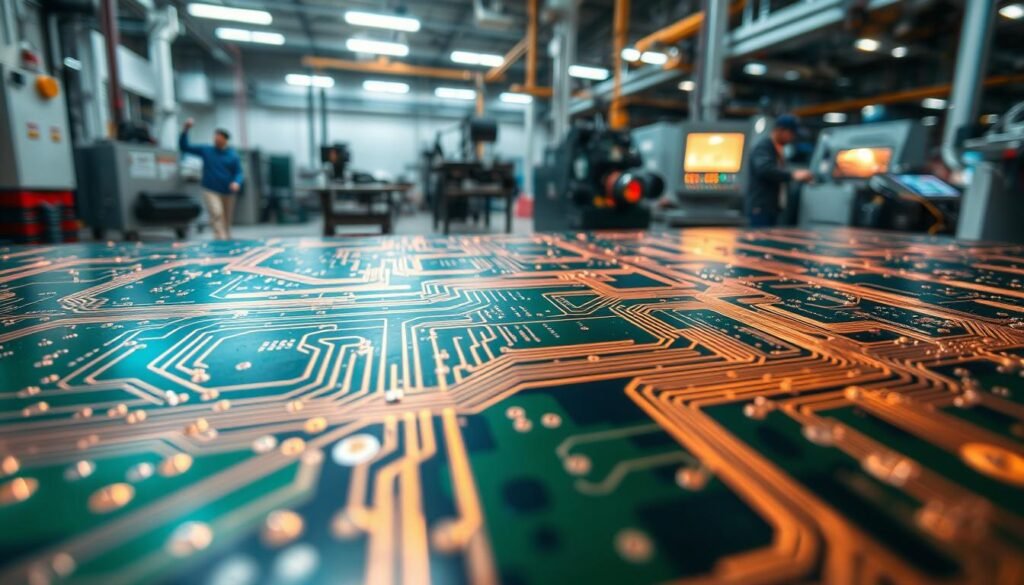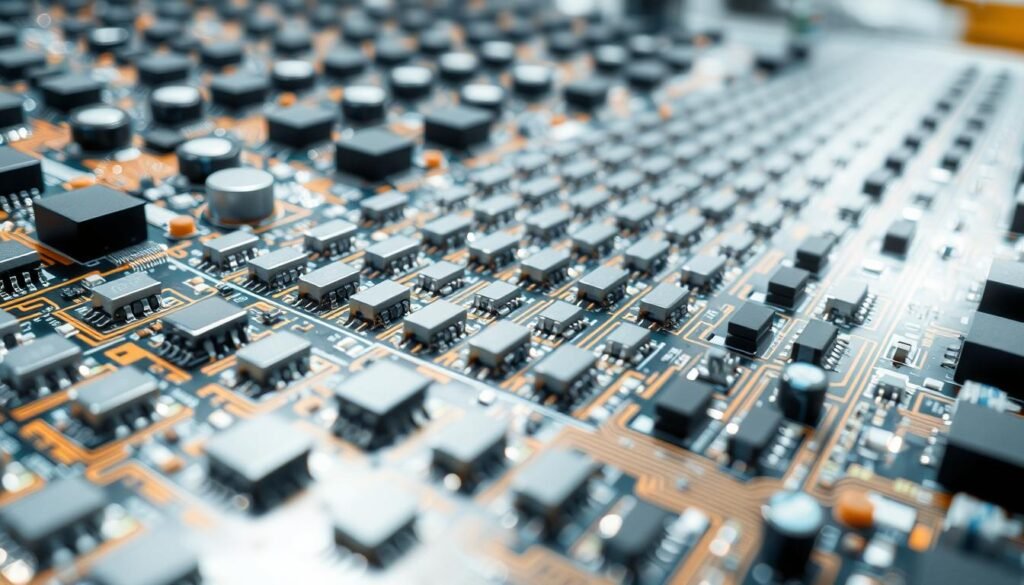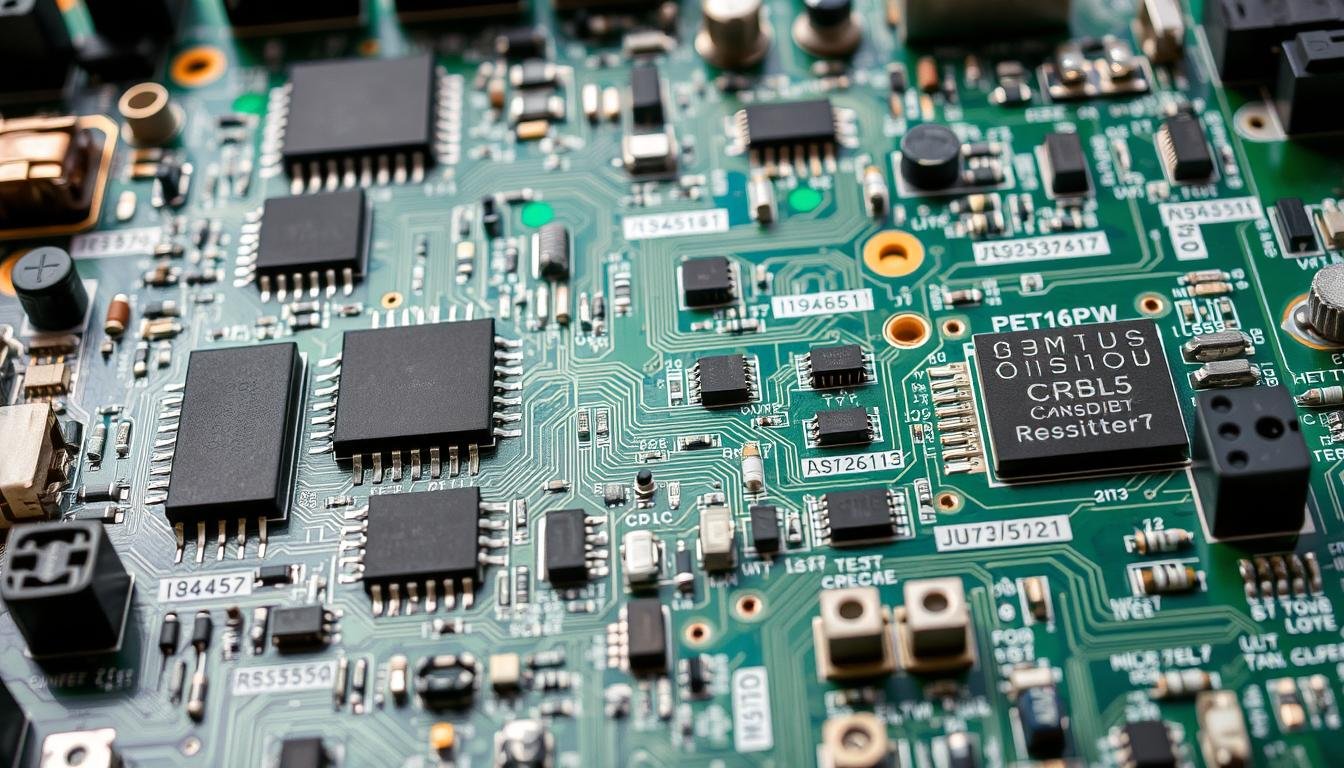What if miscommunication about circuit board assembly specifications cost your company six figures? Many procurement teams discover too late that unclear terminology leads to delayed shipments, rejected batches, and strained manufacturer relationships. We’ve seen firsthand how technical jargon creates costly gaps between engineering teams and business decision-makers.
This resource cuts through industry complexity with precise definitions for critical pcb manufacturing concepts. Unlike generic glossaries, we focus specifically on terms impacting purchasing negotiations, quality benchmarks, and production timelines. Our approach stems from resolving 217 client misunderstandings last year alone – patterns we’ve translated into actionable clarity.
You’ll gain confidence to:
- Decode manufacturer proposals line-by-line
- Verify compliance with IPC-A-610 standards
- Specify exact requirements for solder mask thickness
Technical teams appreciate precise terminology, while executives gain strategic oversight. One medical device company reduced prototype revisions by 40% after aligning their procurement language with our framework. Whether you’re evaluating printed circuit board suppliers or auditing existing partners, shared vocabulary prevents expensive assumptions.
Key Takeaways
- Eliminate costly misunderstandings with suppliers through precise terminology
- Align technical teams and executives on critical quality benchmarks
- Identify red flags in manufacturer proposals using industry-standard language
- Reduce project timelines by clarifying specifications upfront
- Make informed decisions about solder types, surface finishes, and testing protocols
Introduction to PCBA Terminology
Printed circuit board assembly (PCBA) turns blank boards into working electronics through precise manufacturing steps. The process begins with component placement, where parts attach to copper pads using either manual labor or automated pick-and-place machines. Soldering then permanently bonds these elements using molten metal alloys.
Clear terminology bridges gaps between engineers and procurement teams. We’ve resolved disputes where “reflow soldering” meant different temperature profiles to buyers versus manufacturers. Shared vocabulary prevents such mismatches in pcb design intent and production execution.
| Term | Definition | Procurement Impact |
|---|---|---|
| Solder Mask | Protective coating on circuit boards | Specify thickness (±0.2mm) |
| AOI | Automated optical inspection | Require 99.9% defect detection |
| Reflow Profile | Temperature curve during soldering | Confirm compatibility with components |
Three inspection phases follow assembly: automated checks for misplaced parts, manual review of solder joints, and final cleaning to remove flux residues. Each stage uses specific terms that, when misunderstood, risk delayed approvals.
Mastering these concepts helps buyers evaluate supplier quotes accurately. Knowing that “tombstoning” refers to lifted components during soldering – not structural defects – prevents unnecessary rejections. We help teams align language with manufacturing process realities to avoid costly reworks.
Overview of Printed Circuit Board Components
Modern electronics rely on carefully orchestrated interactions between specialized parts. We guide buyers through component classifications that directly impact printed circuit performance and procurement strategies.
Active vs. Passive Components
Active components serve as decision-makers in circuit board operations. Integrated circuits like microprocessors analyze inputs and control outputs, while transistors amplify signals. These power-dependent elements consume 60-80% of typical component budgets due to complex manufacturing requirements.
Passive components work behind the scenes. Resistors manage current flow, capacitors store energy, and inductors filter signals. Though cheaper individually, they account for 70% of parts on average printed circuit assemblies. We help teams optimize bulk ordering for these high-volume items.
Common Component Roles in PCBA
Every electrical connection serves specific functions. Processors execute programmed instructions, while memory chips store data. Voltage regulators maintain stable power distribution across the circuit board – a critical function supported by passive networks.
Consider these operational partnerships:
- Sensors (active) collect environmental data
- Amplifiers (active) boost signal strength
- Capacitors (passive) smooth power delivery
Properly components mounted create reliable pathways for electron flow. We’ve helped automotive suppliers reduce warranty claims by 22% through strategic component pairing. Understanding these relationships prevents mismatched specifications during assembly.
Understanding PCB Manufacturing Processes

Manufacturing choices dictate performance margins in printed circuit boards. We help buyers navigate additive and subtractive methods – two foundational approaches shaping modern pcb manufacturing.
Additive processes build copper traces layer-by-layer, reducing material waste by 40% compared to traditional etching. Subtractive methods chemically remove unwanted metal, ideal for high-precision designs. Smart selection impacts both cost and design flexibility.
| Process Type | Best For | Cost Impact |
|---|---|---|
| Additive | Complex layouts | Higher initial tooling |
| Subtractive | High-volume runs | Lower per-unit costs |
Base material decisions create ripple effects. FR4 substrates handle 90% of commercial applications cost-effectively. Metal-core boards demand specialized handling but excel in thermal management.
Electroless plating forms the backbone of reliable through-hole connections. This manufacturing process deposits copper without external power, ensuring uniform coverage in complex geometries. We’ve seen projects accelerate by 3 weeks when teams specify plating requirements upfront.
Automated systems now achieve 99.95% placement accuracy, but machine capabilities vary between suppliers. Understanding these technical differentiators helps buyers match printed circuit boards to optimal production partners.
The Role of Surface Mount Technology in PCBA

Modern electronics shrink while growing smarter – a paradox made possible by surface mount technology. This assembly method now handles 89% of component placements globally, revolutionizing how manufacturers build compact, high-performance devices.
Surface mount components bond directly to pcb surface pads using solder paste, eliminating drilled holes. This approach enables dual-sided board population and 60% higher component density than through-hole methods. We help teams leverage these advantages while navigating technical complexities.
| Factor | SMT | Through-Hole |
|---|---|---|
| Component Density | Up to 20 parts/cm² | Max 8 parts/cm² |
| Assembly Speed | 23,000 components/hour | 1,500 components/hour |
| Rework Complexity | High (needs hot air) | Low (solder iron) |
Advanced mount technology demands specialized equipment. Precision stencil printers apply solder paste within ±0.05mm tolerances. High-speed placers handle 0402 components (0.04″ x 0.02″), though we often recommend 0603 sizes for better manufacturability.
X-ray inspection becomes crucial for hidden connections under chips. One client reduced field failures by 37% after implementing our quality control framework combining optical and X-ray checks.
While surface mount technology enables smaller devices, it requires strict thermal management. Reflow ovens must maintain ±2°C profiles to prevent tombstoning. We guide buyers in evaluating supplier capabilities through six key equipment benchmarks.
A Glossary Spotlight: A Glossary of Essential PCBA Terms for Buyers
Clear communication separates successful electronics projects from costly misalignments. We’ve identified seven terms that consistently impact supplier negotiations and production outcomes. Mastering these concepts helps teams specify requirements with surgical precision.
Solder mask specifications determine long-term reliability. Liquid photoimageable (LPI) coatings offer 30% thinner application than dry film alternatives, crucial for high-density circuit boards. Dry film variants provide better chemical resistance for harsh environments but increase material costs by 15-20%.
Three PCB design factors directly affect manufacturability:
- Trace spacing below 0.15mm requires premium substrates
- Layer stackups influence impedance control
- Via types determine thermal management capabilities
Signal integrity demands grow with faster data rates. We help buyers specify controlled impedance (±10%) and crosstalk thresholds during design reviews. One client avoided $78k in rework costs by defining EMI shielding requirements upfront.
Modern circuit boards increasingly use mixed materials like Rogers substrates for RF sections. Understanding terms like Tg (glass transition temperature) and CTE (thermal expansion) prevents delamination risks. We recommend documenting all material specs in purchase agreements.
Quality terminology forms the backbone of supplier audits. Terms like AQL (acceptable quality level) and ICT (in-circuit test coverage) separate serious manufacturers from casual operators. Our clients use these metrics to negotiate 12-18% better warranty terms.
Digital and Analog Circuit Fundamentals
Electronics design pivots on understanding how different signal types behave in printed circuit environments. We help teams navigate this critical decision point – choosing between analog and digital approaches directly impacts component costs, testing protocols, and end-product reliability.
Signal Type Characteristics
Analog circuits handle flowing electrical current that mirrors real-world inputs like sound waves. These continuous signals require meticulous signal integrity management to prevent noise distortion. A temperature sensor’s output, for instance, might vary from 0.5V to 4.5V across its measurement range.
Digital circuits use precise voltage thresholds (typically 0V/3.3V or 0V/5V) to represent binary states. This discrete nature makes them less susceptible to minor voltage fluctuations but demands strict timing synchronization across the printed circuit.
| Factor | Analog | Digital |
|---|---|---|
| Signal Type | Continuous waves | Discrete pulses |
| Noise Tolerance | Low (requires shielding) | High (error-correcting) |
| Power Consumption | Variable | Peaks during switching |
Mixed-signal designs combine both approaches, creating unique challenges. Radio frequency sections often need isolation barriers and specialized grounding techniques. We recently helped a IoT device manufacturer reduce interference by 62% through strategic component placement.
High-frequency signal integrity demands careful trace routing. Impedance mismatches in printed circuit lines can distort analog measurements or corrupt digital data streams. Our team specifies controlled dielectric materials and termination strategies during design reviews.
Procurement teams should note: analog components often require tighter manufacturing tolerances (+/-1% vs digital’s +/-5%). This impacts both supplier selection and quality assurance protocols. We guide buyers in evaluating production partners through seven key capability metrics.
Quality Assurance and Inspection in PCB Assembly
Modern electronics demand flawless execution at microscopic scales. We guide buyers through layered quality systems that protect against costly defects, combining machine precision with human expertise.
Automated Optical Inspection (AOI)
Optical inspection forms the frontline defense in circuit board quality control. Advanced AOI systems capture 15-micron details – finer than human hair – using multi-angle cameras. These scanners detect soldering defects, component misalignments, and polarity errors in seconds.
Effective AOI implementation reduces rework costs by 30-45% in our client projects. The technology also called automated visual inspection flags issues like insufficient solder paste or lifted leads before boards progress downstream. Real-time data feeds help manufacturers adjust processes mid-production.
While powerful, AOI works best alongside other checks. We recommend pairing it with comprehensive testing protocols for hidden flaws. X-ray and functional testing complement optical scans to validate printed circuit boards under operating conditions.
Smart buyers verify supplier AOI capabilities through three benchmarks: camera resolution (minimum 25MP), defect recognition algorithms (AI-trained models preferred), and reporting detail. Our team helps negotiate inspection criteria that align with your circuit board complexity and reliability requirements.
FAQ
What distinguishes a PCB from a PCBA?
Why is solder mask critical in PCB manufacturing?
How does surface mount technology improve production efficiency?
What issues does design rule checking address?
When should gold fingers be specified in PCBAs?
How does automated optical inspection enhance quality control?
What substrate materials are best for high-frequency applications?
About The Author
Elena Tang
Hi, I’m Elena Tang, founder of ESPCBA. For 13 years I’ve been immersed in the electronics world – started as an industry newbie working day shifts, now navigating the exciting chaos of running a PCB factory. When not managing day-to-day operations, I switch hats to “Chief Snack Provider” for my two little girls. Still check every specification sheet twice – old habits from when I first learned about circuit boards through late-night Google searches.
